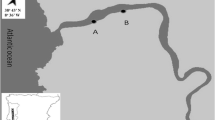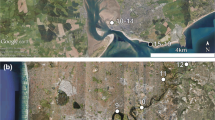Abstract
The vertical distribution of Tubifex tubifex, Limnodrilus hoffmeisteri and L. udekemianus, in a riverine mud was studied over a year. Distribution was dependent upon species identity, season and locality. The size structure of the population, and hence species life history, was of fundamental importance in determining temporal patterns of vertical distribution. A positive correlation between worm length and depth of penetration was clearly demonstrated for all three species. However, the mid-stream populations of the three species were closer to the mud surface during the summer and autumn than were the near-bank populations, although the size structures of the populations were not significantly different. Thus, another factor, possibly the distribution of food, also influenced the vertical distribution of the worms. Cocoon distribution was similar to that of the adult worms. Cocoons of the larger species, L. udekemianus, occurred deeper in the mud than those of T. tubifex. A comparison between the vertical distributions of tubificids in cores sectioned in situ, on the stream bank, and 30 mins later, showed there to be no significant change in distribution with time.
Similar content being viewed by others
References
Aston, R. J., 1973. Field and experimental studies on the effects of a power station effluent on Tubificidae (Oligochaeta, Annelida). Hydrobiologia 42: 225–242.
Berg, K., 1938. Studies on bottom animals of Esrom Lake. K. danske Vidensk. Selsk. Skr. 8: 1–255.
Birtwell, I. K. & D. R. Arthur, 1980. The ecology of tubificids in the Thames Estuary with particular reference to Tubifex costatus (Claparède). In R. O. Brinkhurst & D. G. Cook (eds.), Aquatic oligochaete biology. Plenum Press, New York: 331–382.
Brinkhurst, R. O., K. E. Chua & E. Batoosingh, 1969. Modifications in sampling procedures as applied to studies on the bacteria and tubificid oligochaetes inhabiting aquatic sediments. J. Fish. Res. Bd Can. 26: 2581–2593.
Brinkhurst, R. O. & B. G. M. Jamieson, 1971. Aquatic Oligochaeta of the world. Oliver & Boyd, Edinburgh, 860 pp.
Brinkhurst, R. O. & C. R. Kennedy, 1965. Studies on the biology of the Tubificidae (Annelida, Oligochaeta) in a polluted stream. J. Anim. Ecol. 34: 429–443.
Cole, G. A., 1953. Notes on the vertical distribution of organisms in the profundal sediments of Douglas Lake, Michigan, Am. Midl. Nat. 49: 252–256.
Davis, R. B., 1974. Stratigraphic effects of tubificids in profundal lake sediments. Limnol. Oceanogr. 19: 466–488.
Fisher, J. A. & A. M. Beeton, 1975. The effect of dissolved oxygen or the burrowing behaviour of Limnodrilus hoffmeisteri (Oligochaeta). Hydrobiologia 47: 273–290.
Holdren, G. C. & D. E. Armstrong, 1980. Factors affecting phosphorus release from intact lake sediment cores. Envir. Sci. Technol. 4: 79–87.
Kajak, Z. & K. Dusoge, 1971. The regularities of vertical distribution of benthos in bottom sediments of three Masurian lakes. Ekol. pol. 19: 485–499.
Krezoski, J. R., S. C. Mozley & J. A. Robbins, 1978. Influence of benthic macroinvertebrates on mixing of profundal sediments in southeastern Lake Huron. Limnol. Oceanogr. 23: 1011–1016.
Ladle, M., 1971. The biology of Oligochaeta from Dorset chalk streams. Freshwat. Biol. 1: 83–97.
Lazim, M. N. & M. A. Learner, 1986a. The life-cycle and productivity of Tubifex tubifex (Oligochaeta; Tubificidae) in the Moat-Feeder Stream, Cardiff, South Wales. Holarct. Ecol. 9: 185–192.
Lazim, M. N. & M. A. Learner, 1986b. The life-cycle and production of Limnodrilus hoffmeisteri and L. udekemianus (Tubificidae; Oligochaeta) in the organically enriched Moat-Feeder Stream, Cardiff, South Wales. Arch. Hydrobiol. Suppl. 74: 200–225.
Lazim, M. N. & M. A. Learner, 1987. The influence of sediment composition and leaf litter on the distribution of tubificid worms (Oligochaeta). A field and laboratory study. Oecologia 72: 131–136.
Lenz, F., 1931. Untersuchungen über die Vertikal verteilung der Bodenfauna in Tiefensediment von seen. Ein never Bodeneifer mit Zerteilung-svorrichtung. Verh. int. Ver. Limnol. 5: 232–260.
Maitland, P. S., 1969. A simple corer for sampling sand and finer sediment in shallow water. Limnol. Oceanogr. 14: 151–156.
Milbrink, G., 1969. Microgradients at the mud-water interface. Rep. Inst. Freshwat. Res. Drottningholm. 49: 129–148.
Milbrink, G., 1973. On the vertical distribution of oligochaetes in lake sediments. Rep. Inst. Freshwat. Res. Drottningholm. 53: 34–50.
Milbrink, G., 1975. Population biology of the cestode Caryophyllaeus laticeps (Pallas) in bream, Abramis brama (L.), and the feeding of fish on oligochaetes. Rep. Inst. Freshwat. Res. Drottningholm. 54: 36–51.
Nalepa, T. F. & A. Robertson, 1981. Vertical distribution of zoobenthos in southeastern Lake Michigan with evidence of seasonal variation. Freshwat. Biol. 11: 87–96.
Palmer, M. F., 1968. Aspects of the respiratory physiology of Tubifex tubifex in relation to its ecology. J. Zool. Lond. 154: 463–473.
Poddubnaya, T. L., 1961. Data on the nutrition of the prevalent species on Tubificidae in the Rybinsky Basin. Trad. Inst. Biol. Vodokhran 4: 219–231.
Poddubnaya, T. L. & V. S. Sorokin, 1961. The thickness of the nutrient layer in connection with the movements of the Tubificidae in the ground. Byull. Inst. Biol. Vodokhran. 10: 14–17.
Sarkka, J. & L. Paasivirta, 1972. Vertical distribution and abundance of the macro- and micro-fauna in the profundal sediments of Lake Paijanne, Finland. Ann. zool. fenn. 9: 1–9.
Siegel, S., 1956. Nonparametric statistics for the behavioural sciences. McGraw-Hill, London, 312 pp.
Wavre, M. & R. O. Brinkhurst, 1979. Interactions between some tubificid oligochaetes and bacteria found in the sediment of Toronto Harbour, Ontario. J. Fish. Res. Bd Can. 28: 335–341.
Author information
Authors and Affiliations
Rights and permissions
About this article
Cite this article
Lazim, M.N., Learner, M.A. & Cooper, S. The importance of worm identity and life history in determining the vertical distribution of tubificids (Oligochaeta) in a riverine mud. Hydrobiologia 178, 81–92 (1989). https://doi.org/10.1007/BF00006115
Received:
Revised:
Accepted:
Issue Date:
DOI: https://doi.org/10.1007/BF00006115




